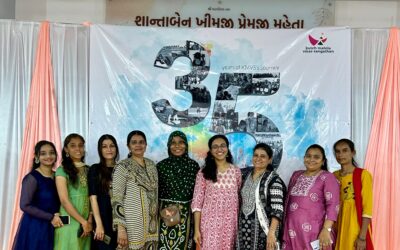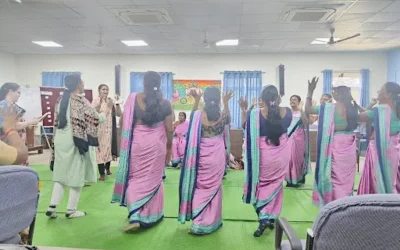At MANAVLOK, the organization I am a part of as an India Fellow, the entire team comes together for a weekly meeting every Monday at 10 AM sharp. Members from all the sub-centers, teachers from our social work college, karyakartas from Manavlok’s women’s wing Manswini, and the karyakartas of the head office itself gather in the conference room. After a month of getting acquainted with the work culture at MANAVLOK, I was invited to be a part of the ritual.
Usually, the meeting is three hours long, where each karyakarta discusses the activities they did in the previous week and present their plan for the next. The discussions are often followed by causal chit-chat sessions, waves of laughter, and CHAI (tea)! The chai is served to 20-25 people in small disposable paper cups. After enjoying the sip, these use-and-throw cups make their way to the dustbin. People here have the habit of consuming tea multiple times a day. Sometimes even more than five times a day. To avoid acidity, they prefer having tea in small quantities. The agenda of using disposable cups were two-fold. First, the size of the 30ml disposable cup was perfect – enough to satisfy their cravings for tea without worrying about the quantity. Second, there was no headache of washing the cups after use. It was easy to dump them in the garbage bins.
On days when disposal cups were not available, tea is served in ceramic cups. But that came with a disadvantage – the size of a ceramic cup is a lot bigger. The secondary disadvantage was – “isko dhooyega kaun?“ (who is going to wash them?) The rule of washing one’s own dishes has been made on multiple occasions yet was never followed religiously.
As each Monday passed by, a small heap of disposal cups could be seen in the dustbin.
The manufacturing process of a paper cup, involves a stage called water-proofing, which packs a layer of low density poly-ethylene (LDPE) on the sides and bottom of the cup to prevent water from getting absorbed by the paper. This LDPE is the only disadvantage in a paper cup. This is because the LDPE, which is a plastic material, prevents the recycling of the paper.
Moreover, here in my organization, the used cups are burnt along with the other waste, releasing more methane, a greenhouse gas with 23 times the heat-trapping power of carbon dioxide. Understanding its repercussions, I started worrying about the situation and thought of doing something to change it. Nothing crossed my mind except replacing them with ceramic cups. Serving tea with half-filled cups seemed like bad tea etiquette. For months, I couldn’t think of anything else and gave up on the idea of doing anything about the situation.
Recently, I went to D-Mart to buy essential accessories for the office’s kitchen along with Manisha tai, our cook. While running from one section to another, my eyes got stuck on one particular thing – the shot glasses.

The Shot Glasses
This was it! The size was perfect to fit just 30ml of chai. But will people be okay with having tea in the glasses used specifically for serving liquor? I started doubting my idea. With a lot of excitement, I ran towards Manisha tai and asked her about my idea of buying shot glasses. She laughed and said, “Ye to bahot behtar hai”. To double check, I asked our driver bhaiya and explained to him the actual usage of the shot glasses. Without any hesitation, he said, “To kya hua, chai ke stall mein to hum kaanch ke glass mein hi chai peete hai na.” I was relieved, but skeptical still. I searched the entire section to look for other cups that are equal in size to shot glasses. I couldn’t find any. I thought of every possible situation that could go wrong. The setup I am working in is rural, 90% of the people in the organization are seniors and I was using the organization’s money to buy shot glasses. I knew my dad wouldn’t have ever approved of having his chai in a liquor glass.
I bought 25 shot glasses, came back to the office, washed them, and waited to use them on the next Monday morning meeting.
The D-Day
The tea was about to be served. My nervousness reached its peak level. I took a risk but deep down I was prepared to hear some critical feedback too. At 11:42 AM tea arrived in the room and one of our karyakartas was serving it to everyone. My eyes were glued to reading the expressions of people. I could hear giggles and whispering. Before anyone could say anything, with a shaky voice I explained to them the reason behind using shot glasses instead of paper cups.

“This is very innovative of you, Sweksha. I appreciate your idea. For anyone who doesn’t know, these are shot glasses, used for serving vodka or tequila. This is more sustainable than using paper cups. Isme chai bhi sahi matra mei aati hai aur garam bhi rehti hai. Hum tequila shots ki jagah chai shots lenge“, said Aniket ji, my mentor.
The room laughed and nodded in agreement. My colleagues looked at me and with a smile on their faces, they approved my idea too. I was happy and relieved. Everyone at MANAVLOK accepted my idea wholeheartedly. It felt like a small win. A small step to bring a teeny-weeny change in our day-to-day routine. This might look like an insignificant step but for me even taking this baby step mattered. A change had been brought and it has been accepted by every single person present in the room. It lifted my morale and motivated me. Although a small challenge was still there – washing the used cups. In the meeting itself, Aniket ji declared that everyone, irrespective of anything, has to wash their used utensils. And to my pleasant surprise, it was followed.
P.S.: Of course the age old argument of whether the water gone in washing the cups even make this a worthwhile decision, in terms of environmental sustainability. On the other hand, the paper cups, a study says there are 1 crore of them being manufactured everyday in India, are not from recycled paper. So the primary plot of introducing them over plastic cups are also questionable. I will keep that exploration of plastic versus glass versus paper for cups, for a later piece.
Reference – https://www.printweek.in/features/paper-cups-future-safe-17486




Well done Sweksha! What a work around! Inspired!
Great Sweksha. This was a good SHOT towards sustainability…
Loved it👍🏻
Cool! 😎
Very nice sweksha, every ocean is filled from small continuous droplets of water. This is a small but a great initiative. Keep on thinking more about it (continuous).
All the best
Well done Swe! Cheers. **sound of chai glasses clinking**